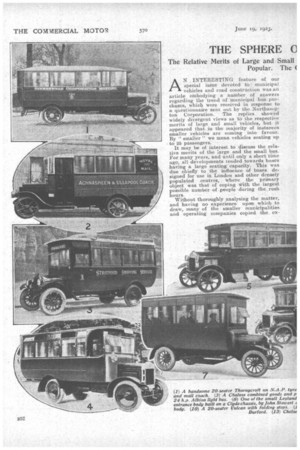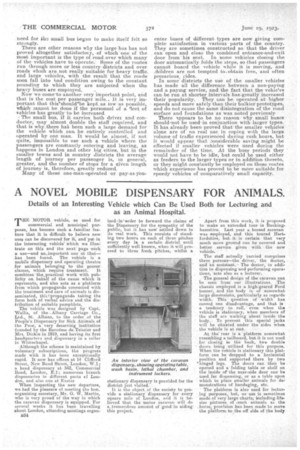THE SPHERE C
Page 16

Page 17

Page 18

If you've noticed an error in this article please click here to report it so we can fix it.
[E LIGHT BUS.
The Relative Merits of Large and Small Popular, The ( Why the Smaller Type is Becoming )f Road Wear.
N INTERESTING feature of our special issue devoted to municipal vehicles and road construction was an article embodying a number of answers regarding the trend of .municipal bus purchases, which were received in response to a questionnaire sent out, by the Nortliamp.ton Corporation. The replies showed widely divergent views as to the respective merits of large and small 'vehicles, but it appeared that in the majority of instance's smaller vehicles are coming into favour By " smaller " we mean vehicles seating up to 25 passengers.
It may be of interest to discuss the relative merits of the large and the small bus. For many years, and until only a short time ago, all developments tended towards buses having a large seating capacity. This was due chiefly to the influence of buses designed for use in London and other densely populated centres, where the primary object was that of coping With the largest possible number of people during the rush hours.
Without thoroughly analysing the matter, and having no experience upon which to draw, many of the smaller municipalities and operating" companies copied the ex ample of the larger bodies and fell blindly into the trap of purchasing buses which, although excellent vehicles in themselves, were, in many cases, far too large for the needs of the smaller communities, which had no such problems as rush hours to solve, and the sparsely populated outlying districts of which did not permit full advantage to be taken of the large passenger accommodation afforded.
To ' begin with, large vehicles naturally cost more to run, and they could not be expected to pay if only lightly loaded during the majority of their working hours. In order to avoid running at a loss, the services had, in many instances, to be curtailed, so that vehicles ran only at long intervals, in the hope that they could then be kept better filled.
As the public began to real;ze the great advantages of passenger road transport and the way in rhich outlying districts could be developed by the provision of adequate services, there came an increased demand for proper facilities, and those responsible . for running the buses—whether they were municipalities or private concerns---were called upon to run vehicles at shorter intervals, and it was here that the urgent
need for pL,.• small bus began to make itself felt so strongly.
There are other reasons why the large bus has not proved altogether satisfactoiy, of which one. of the most important is the type of road.over which many of the vehicles have to operate.Some of the routes run through more or less country districts and over roads which are not really suitable for heavy traffic, and large vehicles, with the result that the roads• soon fall into had condition owing to the constant pounding to which they are subjected when the heavy buses are employed. Now we cometo another very important point, and that is the cost per passenger mile.. It is very important that thieshould'be kept as low as possible, whie' h. ;:ahnot be done if the personnel of a leet of vehicles has greatly•to be increased,
The small bus, if it carries both drives and conductor, may almost double the staff required, and that is why.. there ha l been such a large demand for the vehiole which. cam be entirely controlled and operated by one man. It would be almost, if not quite, impossible to use such a vehicle where the passengers are conttantly entering and leaving, as happens in London and other big cities, but in the smaller towns and in country districts the average length of journey per passenger is, in general, greater, and the number of stops for a given length of journey is, therefore, greatly reduced.
Many of these oneman-operated or pay-as-you enter buses of different types are now giving complete satisfaction in various parts of the country. They are sometimes constructed so that the driver can open and close the combined entrance-and-exit door from his seat. In some vehicles closing the door automatically folds the steps, so that passengerscannot board the vehicle while it is moving, and ahildren are not tempted to-obtain free, and often precarious, rides. In some districts the use of the smaller vehicles has made all the difference between a non-paying and a paying service, and the fact that the vehic'es can•be run at shorter intervals has•greatly increased their popularity. They can be operated at higher speeds and more safely than their bulkier prototypes, and do not cause the same disintegration 1)f the road surface and foundations as was notedpreviously.
There appears to be no reason why small buses shoul¬ be used-in conjunction with larger types. It has already been proved that the smaller vehicles alone are of no real use in coping with the large volume of traffic experienced during rush hours, but -it weulti appear that :Ionsiderable saving might be effected if smaller vehicles were used during the remainder of the time. At the busy periods they would not have to be idle, but could be used either as feeders to the larger types or in addition thereto, or they might constantly be employed on those routes which experience has proved to be more suitable for speedy vehicles of comparatively small capacity.




























